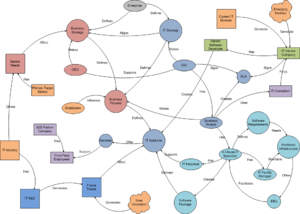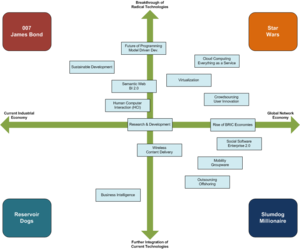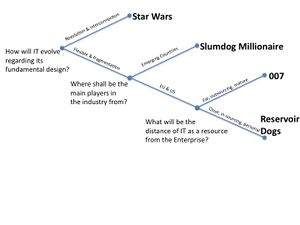Difference between revisions of "The future of Enterprise IT"
Reynerjovian (talk | contribs) |
|||
| (105 intermediate revisions by 4 users not shown) | |||
| Line 1: | Line 1: | ||
=Team members= | |||
* Giorgos Roussakis<br> | * Giorgos Roussakis<br> | ||
* Reyner Karnali<br> | * Reyner Karnali<br> | ||
* Christian Wittenberg<br> | * Christian Wittenberg<br> | ||
* | * Adrian Kentsch | ||
< | Caytmk <a href="http://wvtyfypfjcve.com/">wvtyfypfjcve</a>, [url=http://sklsgjiuqvaa.com/]sklsgjiuqvaa[/url], [link=http://mcslvickulip.com/]mcslvickulip[/link], http://zmylbtaxrczi.com/ | ||
=Research Questions= | |||
2. [[Programming Languages]] | ===Defining Enterprise IT=== | ||
# [[What is Enterprise IT?]] | |||
# [[What are legacy systems?]] | |||
# [[Any common global standard for Enterprise IT?]] | |||
# [[How do you categorize and/or classify Enterprise IT?]] | |||
# [[How long does it take for firms to implement these solutions (e.g. ERP system)?]] <br> | |||
===Technologies=== | |||
# [[Artificial Intelligence with Enterprise IT?]] | |||
# [[How does the emergence of virtualization impact Enterprise IT?]] | |||
# [[What are the Impacts of Internet in the future development of Enterprise IT?]] | |||
# [[What are interesting technologies for improving the way Enterprise IT is applied]] | |||
# [[Why is the Hardware keeps on improving rapidly, while software not? What is fundamentally different?]] | |||
===Financial and Economic=== | |||
# [[What is the GDP market for enterprise IT?]] | |||
# [[What is the average cost that firms pay for implementing Enterprise IT (in this case, ERP)? ]] | |||
===Market & Environment=== | |||
# [[Who are the Primary Target Markets?]] | |||
# [[Who are dominating the Enterprise IT industry?]] | |||
# [[How does Enterprise IT affect the organization?]] | |||
# [[What are relevant trends that influence the future of enterprise IT?]] | |||
# [[How will Outsourcing of Enterprise IT will develop in time? ]] | |||
===Problems=== | |||
# [[What are the problems of current Enterprise IT?]] | |||
# [[Does user experience matter in Enterprise software? What are the caveats?]] | |||
# [[How catastrophic will the future development of programming language will be for Enterprise IT (Impact of it)?]] | |||
===Solutions=== | |||
# [[What are known solutions to solve Legacy problems in Enterprise IT?]] | |||
# [[How can consolidation of solutions be beneficial?]] | |||
# [[What is the most viable future of Enterprise 2.0 ?]] | |||
=Driving Forces= | |||
===Technological forces=== | |||
# [[Programming Languages]] | |||
# [[Cloud Computing and the Enterprise]] | |||
# [[The innovative Open alternative]] | |||
# [[The shift towards Semantics in Business Intelligence]] | |||
# [[Content Delivery in Location Aware Applications from converged 3G/Wireless Internet]] | |||
# [[Increasing Human-Computer Interaction]] | |||
===Social forces=== | |||
# [[Dynamic Mobile Workspace]] | |||
# [[The increasing use of Social Software]] | |||
# [[R&D and Innovation programs]] | |||
===Economical forces=== | |||
# [[The Economic Climate and SMEs]] | |||
# [[The Rise of BRIC Economies]] | |||
# [[Sustainable Development & Global Economy]] | |||
=Systems Diagram= | |||
[[Image:Enterprise_IT_Systems_Diagram.png|thumb| | |||
<b>Systems Diagram</b><hr> | |||
Meaning of colors and shapes:<hr> | |||
<b>Gray</b> The Enterprise<br> | |||
<b>Purple</b> Business Core<br> | |||
<b>Navy Blue</b> IT Core<br> | |||
<b>Aqua Blue</b> In-House IT<br> | |||
<b>Deep Blue</b> External IT<br> | |||
<b>Indigo</b> B2B Partner<br> | |||
<b>Green</b> Outsourcing Party<br> | |||
<b>Orange</b> Key Enablers<hr> | |||
<b>Big Circle</b> Internal Feature<br> | |||
<b>Small Circle</b> Assist Feature<br> | |||
<b>Square</b> External Feature<br> | |||
<b>Oval</b> Internal Role<br> | |||
<b>Rectangular</b> External Role<br> | |||
<b>Cloud</b> Intangible Presence]] | |||
The key enablers identified on the Enterprise IT systems diagram happen first of all at a technological level and second of all at a social and economical level. | |||
Technological factors are represented by the IT industry and their R&D programs, but also by demand from the primary target market and by user innovation coming from the Internet cloud. | |||
Social factors are represented by company employees and by social interactions that take place on the Internet between customers and between lead-users. | |||
Economical factors are represented by the choice enterprises have when trying to discover the best solution for their IT development. This can either happen in-house, can be outsourced or offshored, or can be a combination of options. Furthermore, outsourcing/offshoring can be done either with current IT markets, mostly Western, or with emerging markets, such as the BRIC, the decision depending on socio-economical aspects. | |||
The emergence of BRIC economies as well as influences coming from the Internet cloud are yet intangible aspects, hence hard to predict, but with potential influence on Enterprise IT. | |||
<b> | =Scenarios= | ||
[[Image:Enterprise_IT_Scenarios.png|thumb|<b>Four Scenarios</b>]] | |||
[[Image:Scenario_Tree.jpg|thumb|<b>Scenario Tree</b>]] | |||
Supporting our discovery of six technological driving forces and six socio-economical driving forces, three for each, the systems diagram points out that four scenarios could possibly emerge, given the extent to which enterprises embrace on the one hand technological change and on the other hand socio-economical change. | |||
The four scenarios, presented below, have been given resembling Hollywood movie names: | |||
# <h2>[[Star Wars]]</h2> | |||
# <h2>[[007 - James Bond]]</h2> | |||
# <h2>[[Slumdog Millionaire]]</h2> | |||
# <h2>[[Reservoir Dogs]]</h2> | |||
<br> | |||
==Discussion== | |||
After presenting the scenarios and findings there were some constructive and additive comments. In general there was a PEST approach to the subject. Drop an ear in the conversation and feedback that took place while presenting the findings in the DTN offices, Amsterdam. [[Media:Enterprise_IT_Discussion.mp3]] | |||
Latest revision as of 18:02, 10 March 2010
Team members
- Giorgos Roussakis
- Reyner Karnali
- Christian Wittenberg
- Adrian Kentsch
Caytmk <a href="http://wvtyfypfjcve.com/">wvtyfypfjcve</a>, [url=http://sklsgjiuqvaa.com/]sklsgjiuqvaa[/url], [link=http://mcslvickulip.com/]mcslvickulip[/link], http://zmylbtaxrczi.com/
Research Questions
Defining Enterprise IT
- What is Enterprise IT?
- What are legacy systems?
- Any common global standard for Enterprise IT?
- How do you categorize and/or classify Enterprise IT?
- How long does it take for firms to implement these solutions (e.g. ERP system)?
Technologies
- Artificial Intelligence with Enterprise IT?
- How does the emergence of virtualization impact Enterprise IT?
- What are the Impacts of Internet in the future development of Enterprise IT?
- What are interesting technologies for improving the way Enterprise IT is applied
- Why is the Hardware keeps on improving rapidly, while software not? What is fundamentally different?
Financial and Economic
- What is the GDP market for enterprise IT?
- What is the average cost that firms pay for implementing Enterprise IT (in this case, ERP)?
Market & Environment
- Who are the Primary Target Markets?
- Who are dominating the Enterprise IT industry?
- How does Enterprise IT affect the organization?
- What are relevant trends that influence the future of enterprise IT?
- How will Outsourcing of Enterprise IT will develop in time?
Problems
- What are the problems of current Enterprise IT?
- Does user experience matter in Enterprise software? What are the caveats?
- How catastrophic will the future development of programming language will be for Enterprise IT (Impact of it)?
Solutions
- What are known solutions to solve Legacy problems in Enterprise IT?
- How can consolidation of solutions be beneficial?
- What is the most viable future of Enterprise 2.0 ?
Driving Forces
Technological forces
- Programming Languages
- Cloud Computing and the Enterprise
- The innovative Open alternative
- The shift towards Semantics in Business Intelligence
- Content Delivery in Location Aware Applications from converged 3G/Wireless Internet
- Increasing Human-Computer Interaction
Social forces
Economical forces
Systems Diagram

Meaning of colors and shapes:
Gray The Enterprise
Purple Business Core
Navy Blue IT Core
Aqua Blue In-House IT
Deep Blue External IT
Indigo B2B Partner
Green Outsourcing Party
Orange Key Enablers
Big Circle Internal Feature
Small Circle Assist Feature
Square External Feature
Oval Internal Role
Rectangular External Role
Cloud Intangible Presence
The key enablers identified on the Enterprise IT systems diagram happen first of all at a technological level and second of all at a social and economical level.
Technological factors are represented by the IT industry and their R&D programs, but also by demand from the primary target market and by user innovation coming from the Internet cloud.
Social factors are represented by company employees and by social interactions that take place on the Internet between customers and between lead-users.
Economical factors are represented by the choice enterprises have when trying to discover the best solution for their IT development. This can either happen in-house, can be outsourced or offshored, or can be a combination of options. Furthermore, outsourcing/offshoring can be done either with current IT markets, mostly Western, or with emerging markets, such as the BRIC, the decision depending on socio-economical aspects.
The emergence of BRIC economies as well as influences coming from the Internet cloud are yet intangible aspects, hence hard to predict, but with potential influence on Enterprise IT.
Scenarios
Supporting our discovery of six technological driving forces and six socio-economical driving forces, three for each, the systems diagram points out that four scenarios could possibly emerge, given the extent to which enterprises embrace on the one hand technological change and on the other hand socio-economical change.
The four scenarios, presented below, have been given resembling Hollywood movie names:
Discussion
After presenting the scenarios and findings there were some constructive and additive comments. In general there was a PEST approach to the subject. Drop an ear in the conversation and feedback that took place while presenting the findings in the DTN offices, Amsterdam. Media:Enterprise_IT_Discussion.mp3

